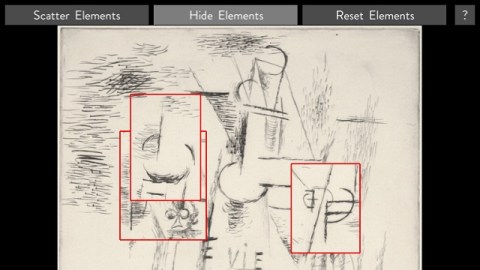How Picasso and Braque Play Games With Your Eyes, and Now Your iPad

Georges Braque once said that he and Pablo Picasso were “roped together like mountain climbers” during the formative years of Cubism—1910 through 1912. Picasso and Braque scaled the mountain of Western art tradition and then turned the mountain upside down through their artistic gamesmanship that took every aspect of what we knew of art up to then and made it look like child’s play. Picasso and Braque: The Cubist Experiment, 1910–1912, which runs at the Kimbell Art Museum through August 21, 2011, studies the aesthetic chess match the two artists played in tandem for those two years and allows viewers today to play and experiment along on their iPads.
Cubism isn’t an easy art movement to understand, or to love. Teasing out the visual puzzles laid out by Picasso and Braque taxes the brain as it stretches the imagination beyond the mimetic devices of shading and perspective we normally rely on. Previous exhibitions of Cubist art hoped to gain understanding through the immersion approach—more is more. Eik Kahng, chief curator at the Santa Barbara Museum of Art (the exhibition’s second stop), decided to take a more intimate approach to Cubism in which less is more. Featuring only 16 paintings and 20 etchings and drypoints, Picasso and Braque targets the heart of the Cubist experiment with just enough examples done thoroughly and well to get the point across to a general audience. “Judge me by my size, do you? Hmm? Hmm,” Yoda famously said to Luke Skywalker in Star Wars. “And well you should not.” Don’t judge Picasso and Braque by its size—the force of the ideas presented is strong and, more importantly, understandable to more than just specialists.
“To experience through these singular canvases the strangeness of that apocalyptic moment and these two painters’ seeming ambition to undo—or should I say, redo?—the Western representational tradition, to feel the urgency of this unimaginable drop-off into an almost, but not quite, recasting of the representational agencies of painting,” Kahng breathlessly writes in her introduction to the catalog, “how could this not be exciting?” Much of the excitement comes from the high stakes of the game Picasso and Braque were playing: nothing less than the wholeness of the world. In “A Project for Wholeness,” Charles Palermo explains how the Cubists “felt the need to trouble the autonomy of objects in order to preserve the fullness (the erotic penetrability, [Leo] Steinberg might say) of the world pictured.” The only way to save the world in its completeness is to shatter its individual components and allow them to penetrate (with all the sexual connotations of the word) one another. Picasso and Braque thus complete the mission begun by Cezanne, who hoped “to make the finite canvas contain the breadth of the experienced world,” Palermo argues. Cubism craves for the infinite and challenges the viewer to come along.
What sets Picasso and Braque apart from your typical exhibition is the inclusion of iPad technology right there in the galleries. Forty iPads will be available to the public for free, each already loaded with iCubist, an iPad application designed and produced by Reza Ali specifically for this show. The app (which will soon be available at iTunes) allows one to see individual works at different light frequencies (ultraviolet and infrared) and at high resolution, thus revealing the minute details missed by the naked eye, even when standing before the work in the flesh. Christine Poggi’s essay on Cubist Faktura wonderfully illuminates the need to appreciate these details, which “in [their] cacophony… return us to our senses: articulated, intensified, intermingled.” Poor conservation choices over the decades have “flattened” to oblivion by varnish many of Picasso and Braque’s touches, Claire Barry and Bart J.C. Devolder explain in the catalog, making pristine Cubist works from this period rare. iCubist helps keep those touches alive.
In the spirit of the Cubist game, another feature allows users to deconstruct a Cubist composition and then try to puzzle it back together (see image above). This hands-on approach allows users to think and act like a Cubist (hence, iCubist) in a way previously possible only in a studio with paint and brush. Other features allow you to compare and contrast Picasso and Braque’s individual styles and to study the history of the movement in context. The educational value of iCubist goes well beyond knowing and understanding Cubism. The interactive “game” features, once widely available, will offer young and old opportunities to flex their creative muscles on a visual level. For today’s visually oriented youth struggling with developing creative and critical thinking skills, iCubist might be a fun way to become the next Picasso or Braque in some field.
Unfortunately, “intimate” too often acts as code in museum circles for “small” or “cheap.” The intimacy of Picasso and Braque: The Cubist Experiment, 1910–1912 is neither of those things. Rather, it is the intimacy of the laboratory, but a fun laboratory where mad scientists blow things up and then sift through the pieces smiling. And with iCubist on the iPad, you, too, can blow things up and be a mad scientist with pictures. You’ll come away from Picasso and Braque knowing more about Cubism, but more importantly, you’ll come away knowing more about yourself.
[Image: Screen shot from the iCubist app for the iPad designed and produced by Reza Ali for the Santa Barbara Museum of Art and the Kimbell Art Museum.]
[Many thanks to the Kimbell Art Museum for providing me with the image above and a review copy of the catalog to Picasso and Braque: The Cubist Experiment, 1910–1912, which runs through August 21, 2011.]





